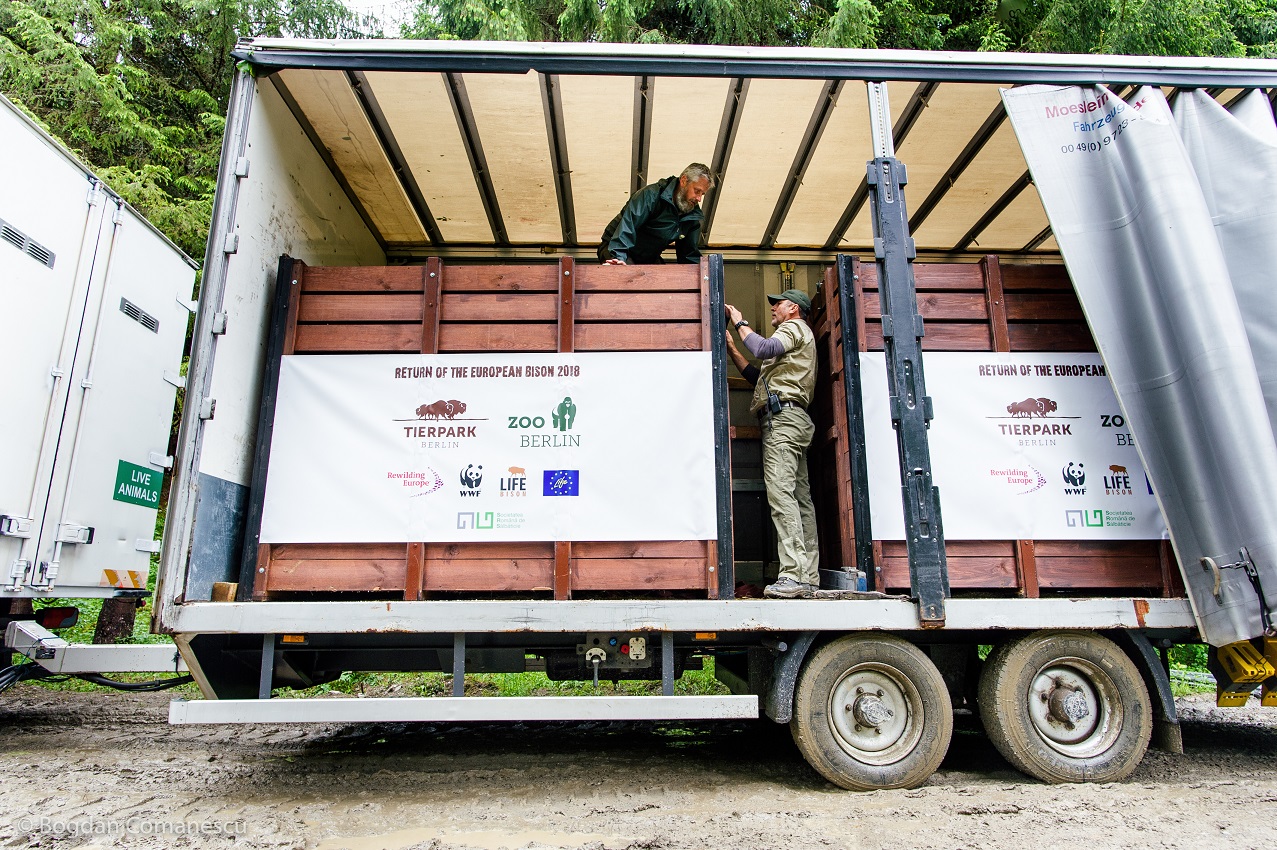For almost a century, idyllic natural landscapes in Europe have been missing a very special species. Red deer stalk across the grassland, brown bears amble through the forests, and beavers build dams across mountain streams – but where are the bison? Europe’s largest land mammal became extinct in the wild in 1927. But now, thanks to a WWF reintroduction project involving Tierpark and Zoo Berlin, European bison are returning to the wilds of Romania.
Five bison left Berlin for Romania on 15 May 2018. Three of the animals were born at the Tierpark, one was born at Zoo Berlin, and the other came from the Damerower Werder bison reservation in northern Germany. This autumn, along with bison from other European animal parks, the five German bison will be released close to the Romanian municipality of Armeniș in the Țarcu Mountains at the edge of the Southern Carpathians. The specific individuals in the group were chosen for this reintroduction project according to social and genetic criteria. Tierpark Berlin’s female bison Tirunesh, who was born in 2010, will be the herd’s matriarch, as the other members of the group are still very young.
The bison will spend a few months in a fenced area, getting accustomed to their new home. Then, in the autumn, the fences will be opened, allowing the bison to go forth and contribute to the biological diversity of this natural landscape. “Bison have a key role to play in maintaining the ecosystem of the Southern Carpathians,” says Tierpark Berlin curator and deputy Zoological Director Christian Kern. “As Europe’s largest herbivore, they are indispensable. Their unique grazing behaviour, which results in patchy distribution of vegetation, creates essential living space for other animal and plant species.”
The Romanian branch of WWF has assumed the organisation, coordination and scientific support of the bison reintroduction project on the ground. It is also responsible for the subsequent observation of the animals and their future offspring. At least one individual from each group will be fitted with a GPS collar to enable researchers to track the development of the various populations. Berlin’s matriarch Tirunesh was fitted with her collar this April.
In 2018 a total of 24 bison from nine European zoological institutions will be returned to the wild in two Romanian nature reserves – one in the Țarcu Mountains and the other in the Rusca Mountains, both in the Carpathians. The two areas cover a total of 83,000 hectares. The first bison were reintroduced in the Țarcu Mountains in 2016, and they reproduced in 2017. Thirty of the animals are now living there. “Over the next 25 years, we hope to see the bison population in the Southern Carpathians grow to around 1,000 individuals,” says Dr Mariana Druga, team leader of the rewilding project in the Southern Carpathians. This makes the project the largest European bison reintroduction programme ever launched. Other project aims are to establish an on-site breeding centre and to limit the threats facing the bison. The project is financed by the organisation Rewilding Europe and LIFE, the EU’s financial instrument supporting environmental, nature conservation and climate action projects.
As a result of hunting by humans, the European bison became extinct in the wild in 1927. It was only thanks to the presence of 70 bison in captivity – primarily in zoos – that the species could be saved from total extinction. In August 1923 an organisation was launched with the aim of helping the species recover through a carefully planned breeding programme. Founded at Zoo Berlin, this initiative of European zoo directors and scientists was called the Society for the Protection of the European Bison. It was the precursor to the European Endangered Species Programmes that are in place for many threatened species today.
European bison have been housed at Zoo Berlin since 1872, and the Tierpark has contributed greatly to the survival of the species since it opened in 1955. More than 200 European bison have been born in Berlin. Captive breeding has been the basis for all wild populations in Europe, and there are currently around 1,450 of the animals living in 14 populations across the European Union. However, since most of these populations are isolated and only five of them have more than 100 members, the European bison is still considered a threatened species by the International Union for Conservation of Nature (IUCN).
Zoo and Tierpark Director Dr Andreas Knieriem is thrilled about the contribution Berlin is making to the reintroduction of the European bison: “Securing reserve populations and reintroducing species into sustainably protected natural habitats are two of the most important tasks for modern zoological institutions. This is a wonderful example of how in situ and ex situ conservation efforts are increasingly complementing one another.”
